Abstract
OBJECTIVE: To examine whether patients admitted for treatment of a myocardial infarction (MI) who live farther from their source of care are less likely to be followed in an outpatient clinic, and whether patients who receive follow-up care are less likely to die or to have a subsequent acute care admission. DATA SOURCE: Department of Veterans Affairs (VA) databases to identify a national sample of 4,637 MI patients discharged in 1992, their use of care, and vital status within the subsequent year. Sociodemographics, comorbid diagnoses, invasive cardiac procedures, hospital teaching status, and distance to patients' admitting hospital were determined. STUDY DESIGN: Using these longitudinal data, we examined the relationship between patient characteristics, distance to care, and use of outpatient care after discharge. We then examined the relationship between the use of ambulatory care and subsequent death and readmission. PRINCIPAL FINDINGS: Patients living more than 20 miles from their admitting hospital were less likely to use ambulatory services. Patients receiving ambulatory care were 79 percent as likely to die within the year as those without any follow-up care (95% C.I. = 0.66, 0.94). Patients living more than 20 miles from their admitting hospital were more likely to die independent of their likelihood of receiving VA outpatient follow-up. Among patients who did not die in the subsequent year, those receiving ambulatory care were 33 percent more likely to be readmitted to a VA hospital with a cardiac diagnosis (95% C.I. = 1.12, 1.57). CONCLUSIONS: Distance may pose a barrier to outpatient follow-up for some VA patients after a MI. It also may limit patients' ability to access medical care quickly in the event of a recurrent acute event. Ambulatory care after discharge may be an important factor determining survival for patients with cardiac disease.
Full text
PDF

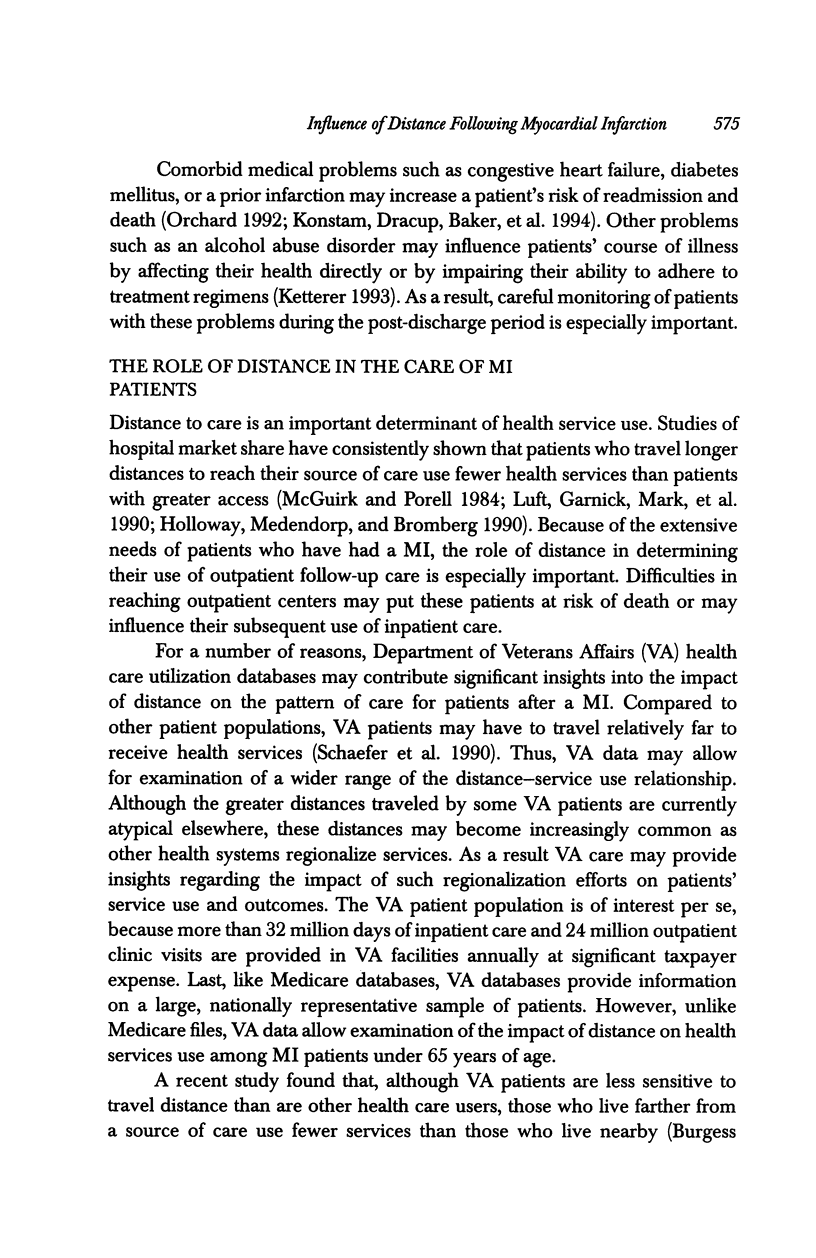
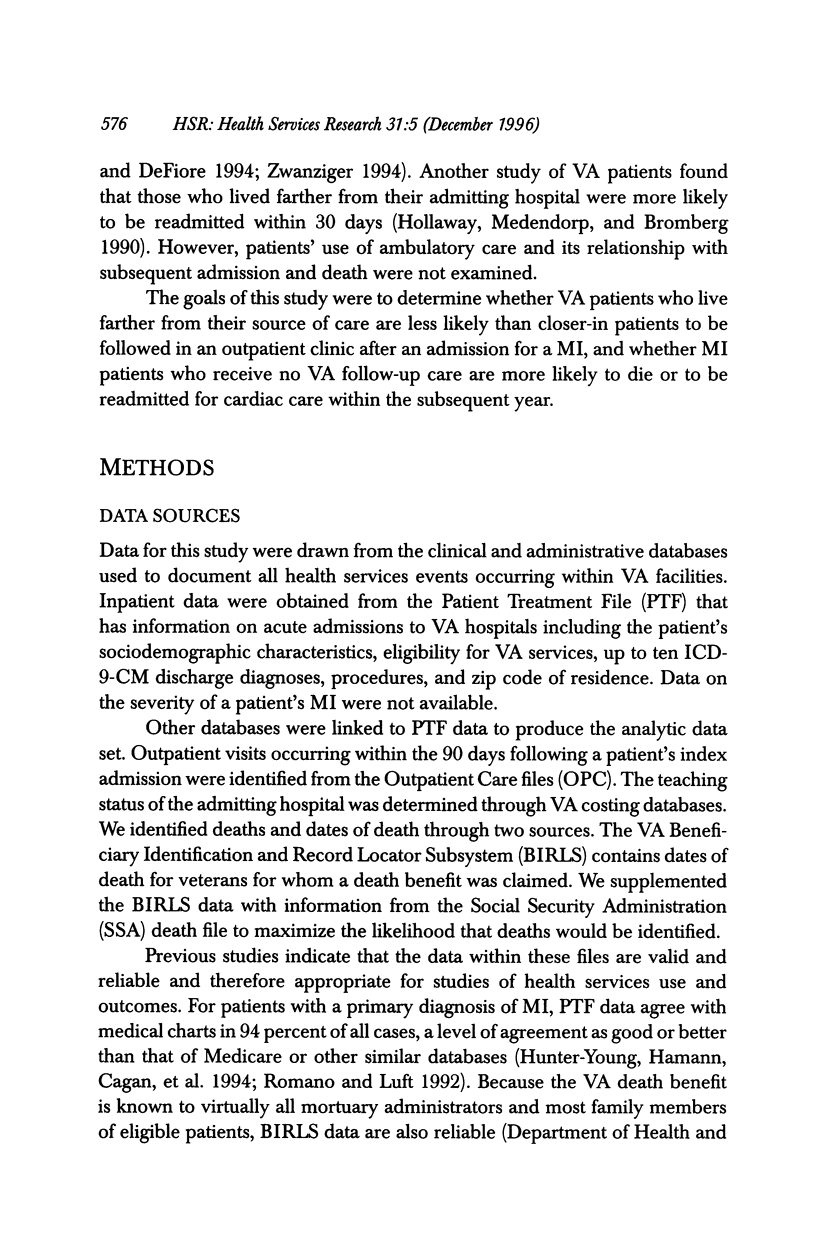
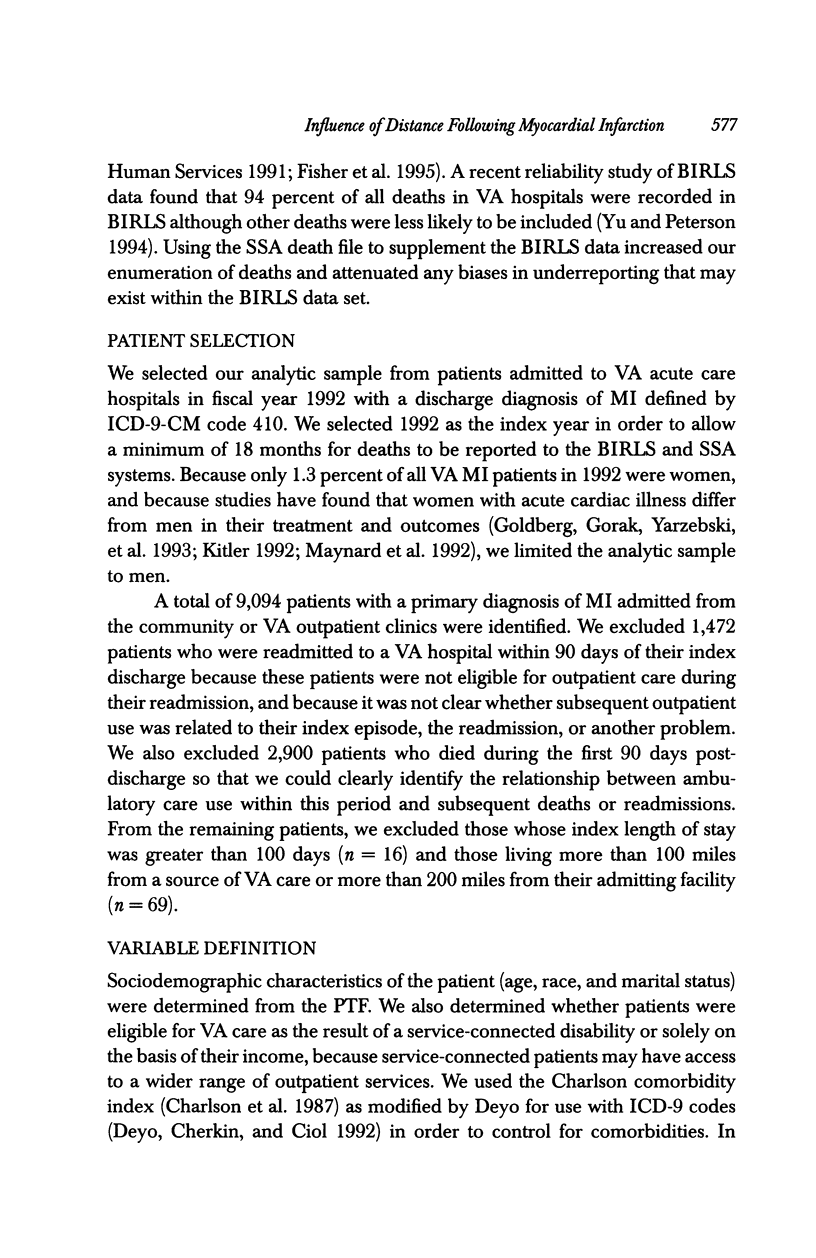
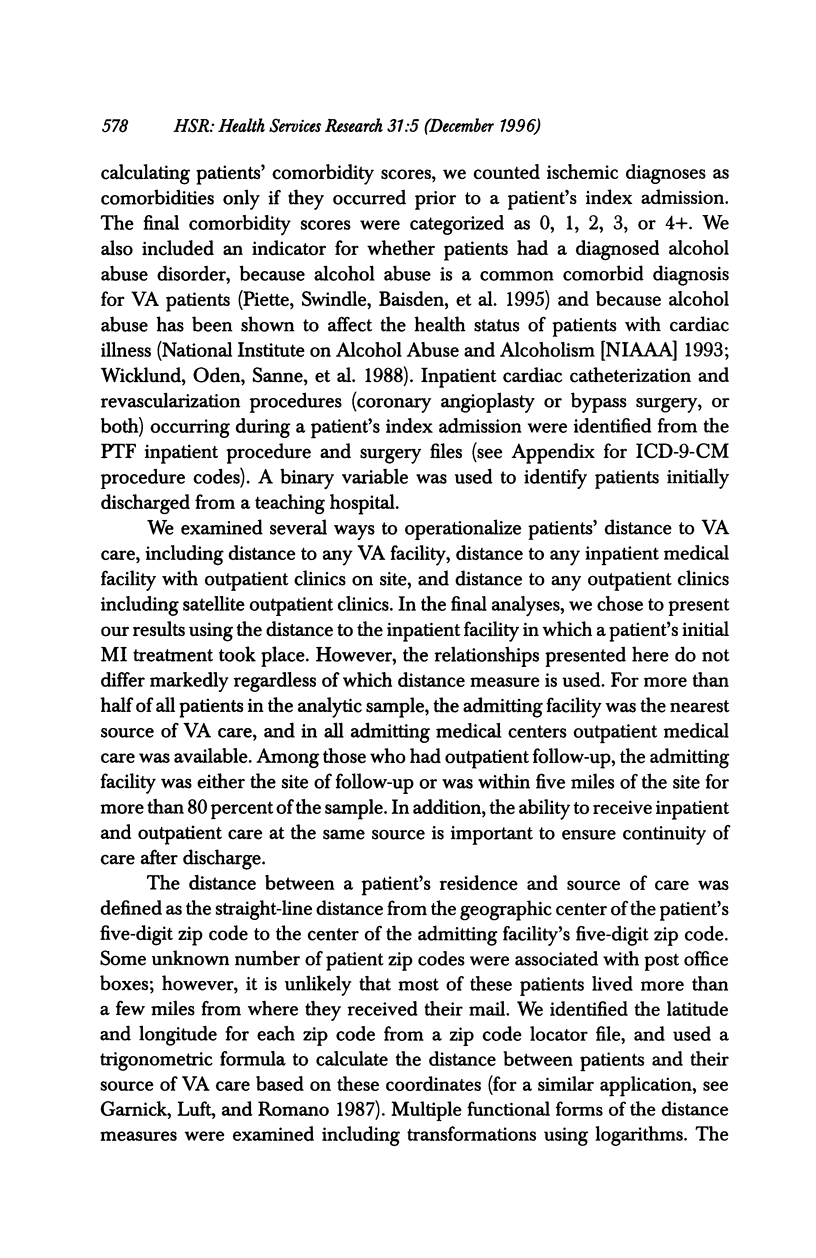




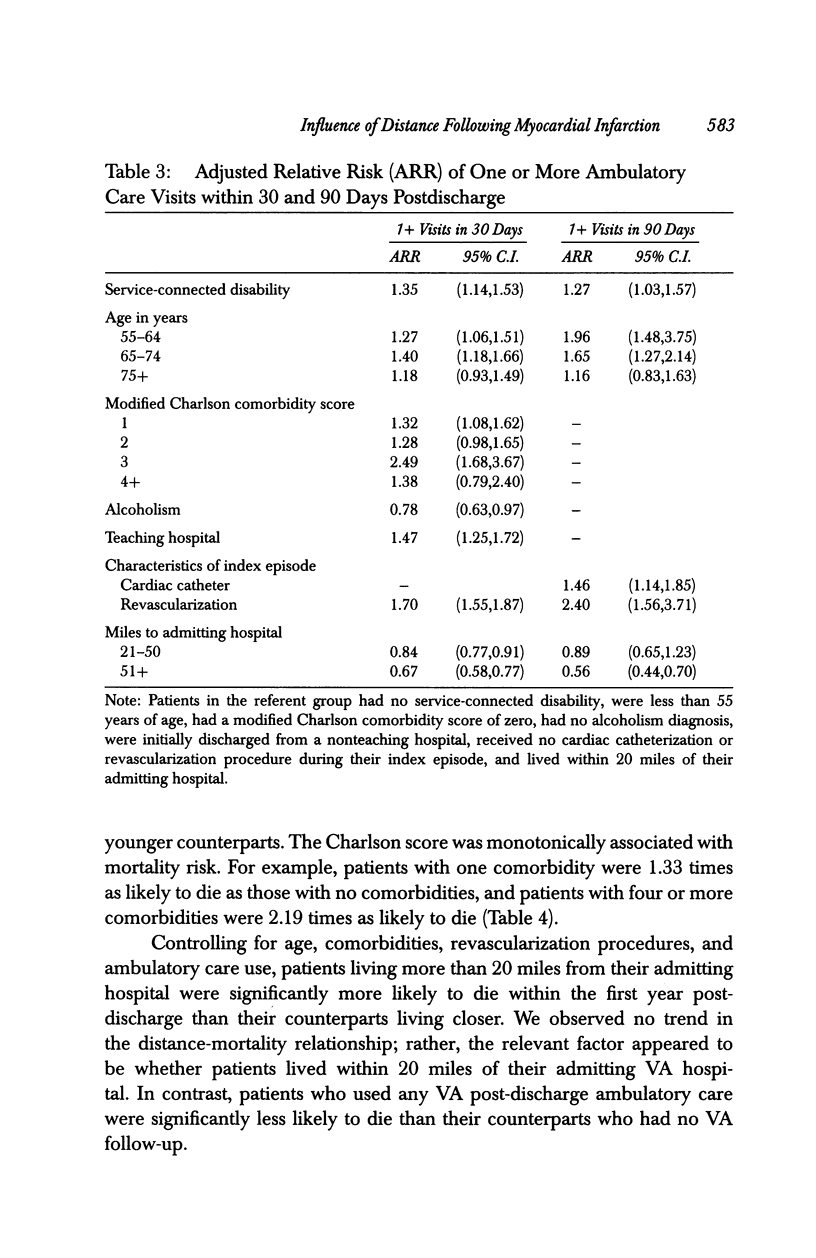
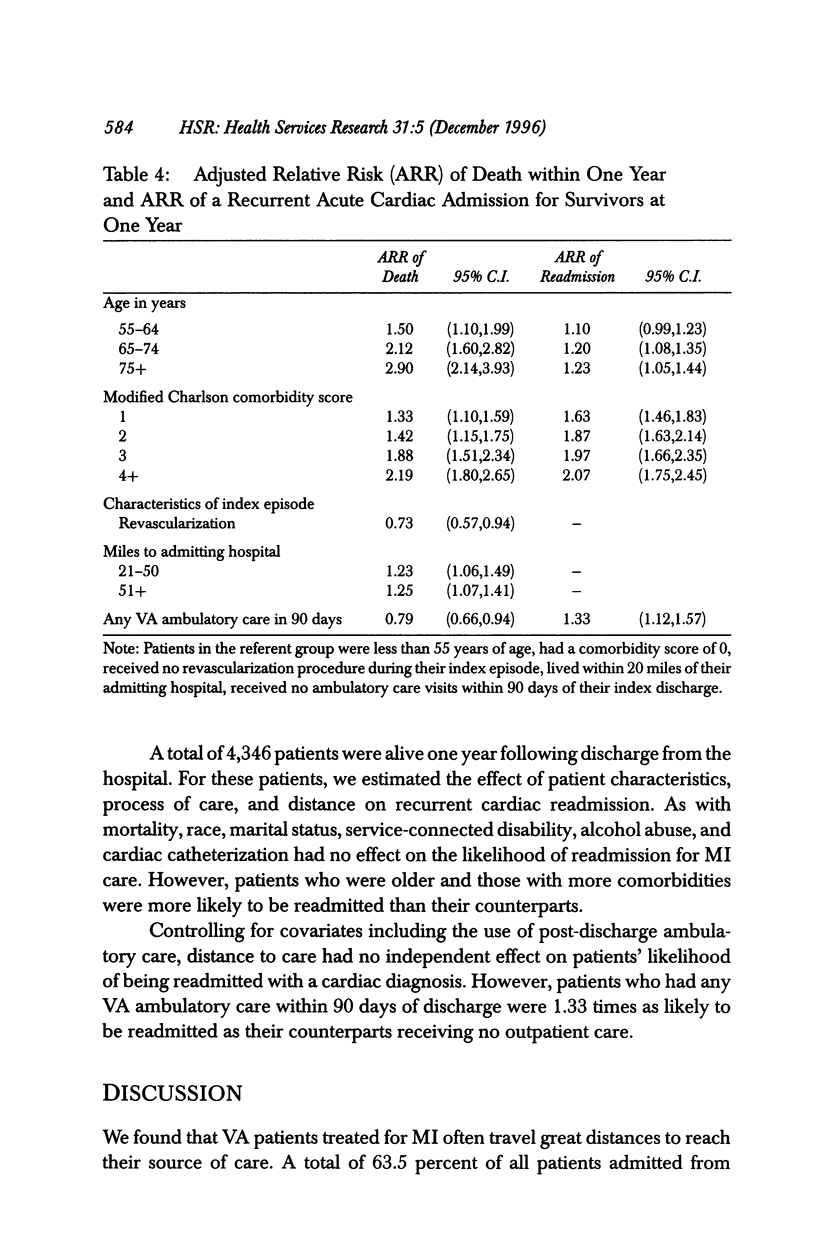
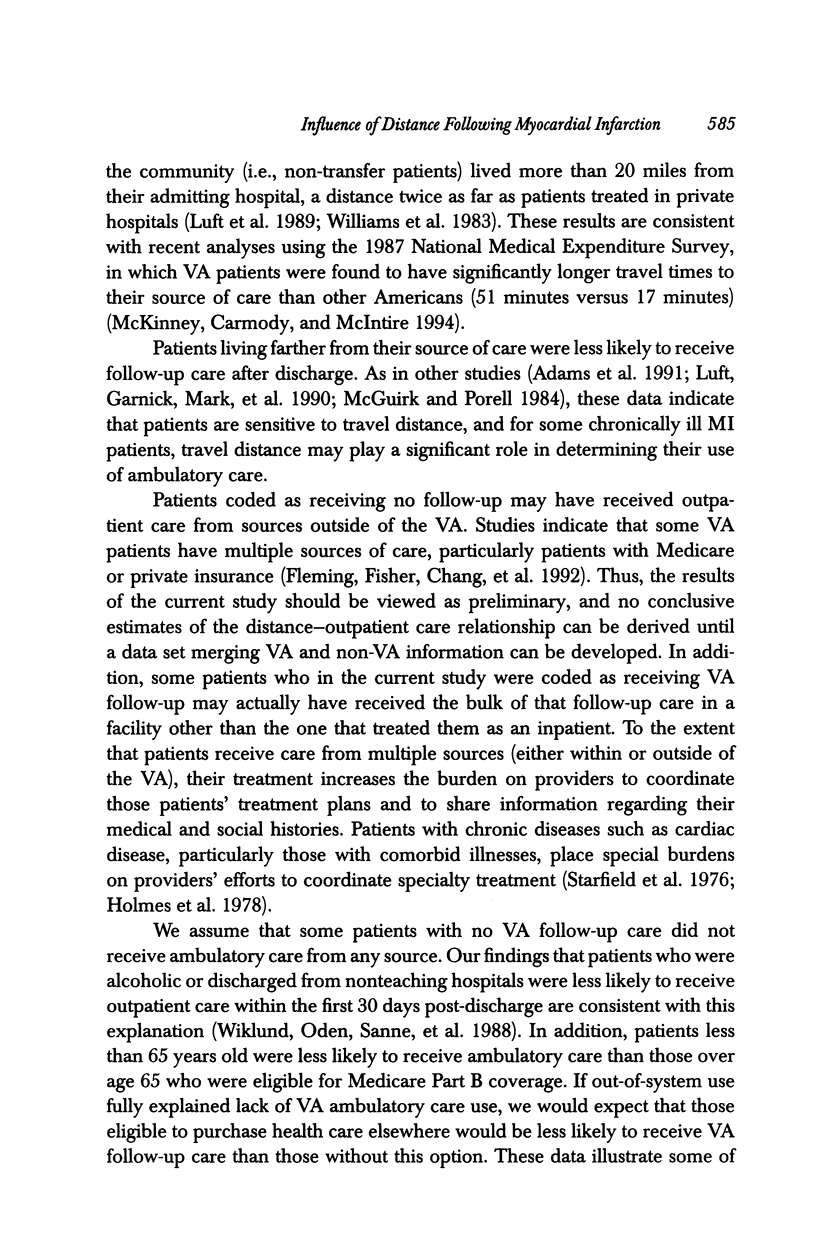



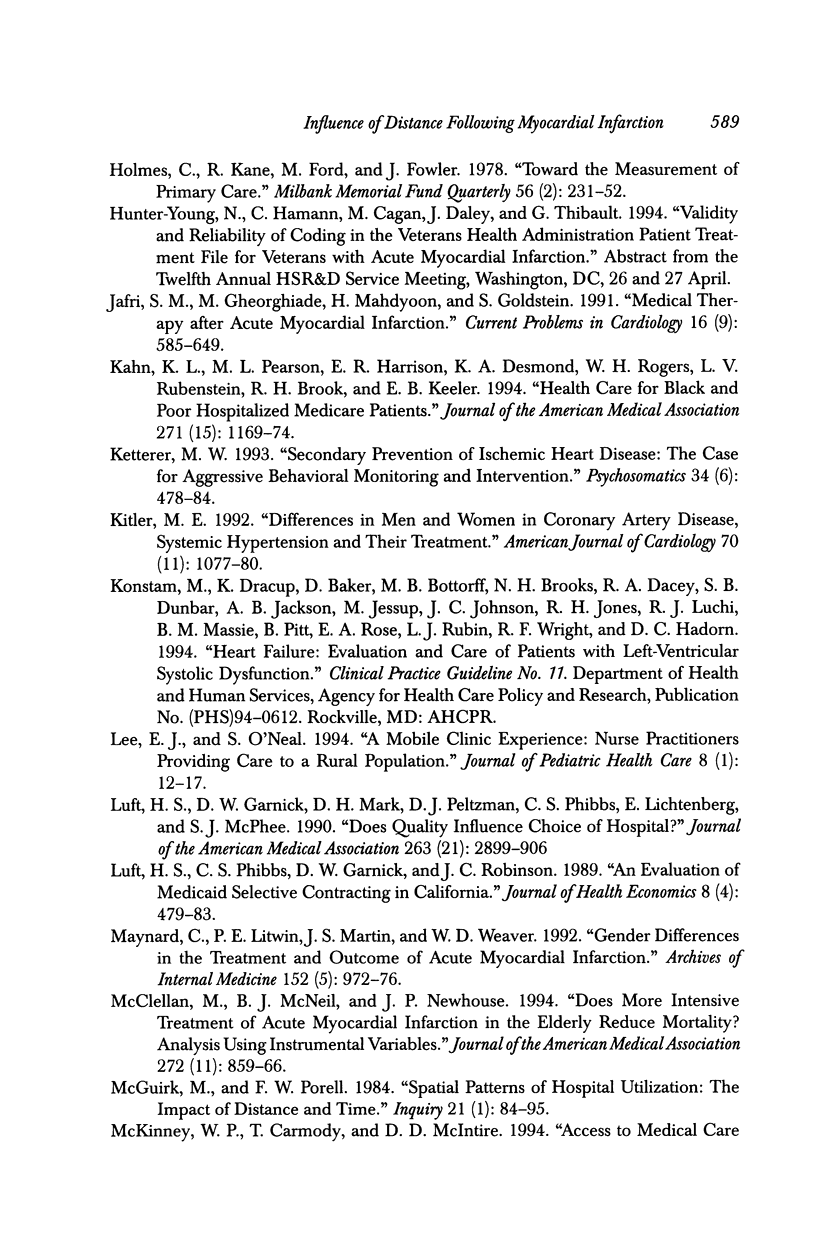
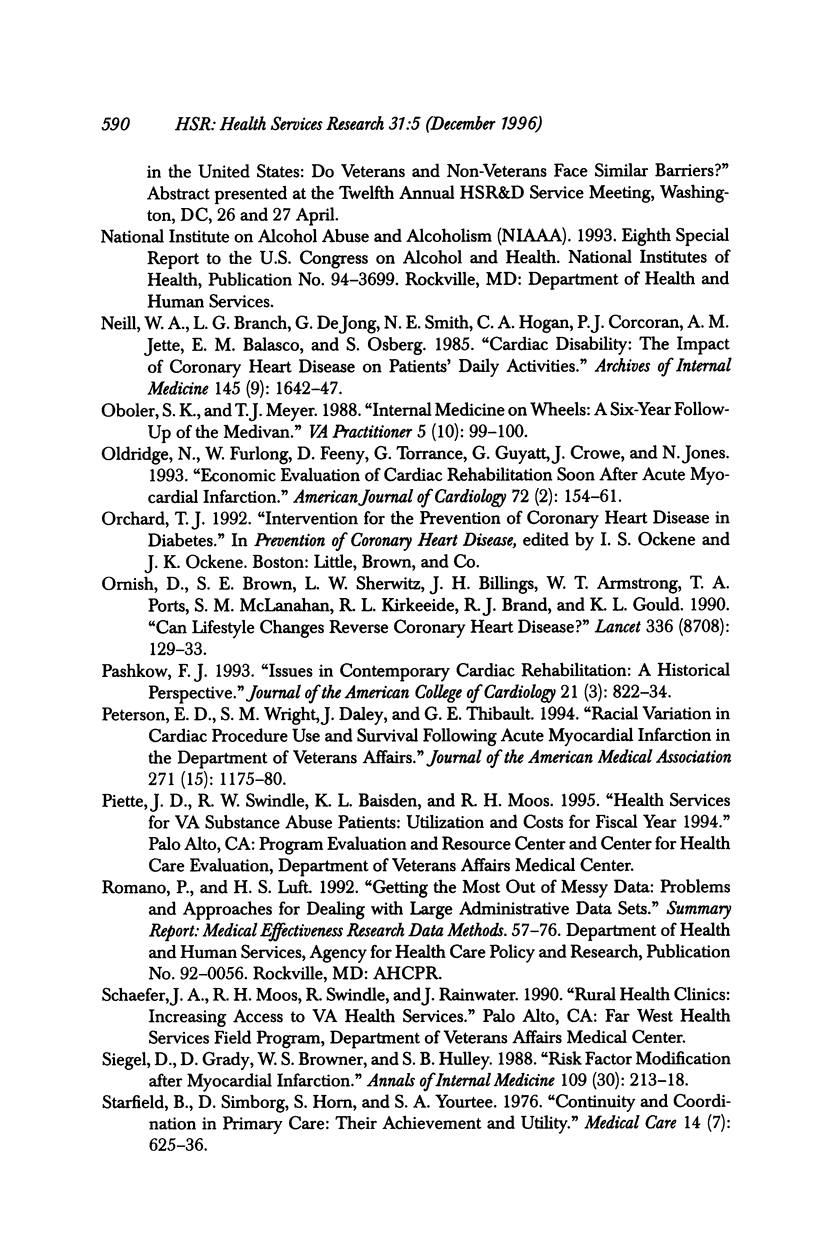

Selected References
These references are in PubMed. This may not be the complete list of references from this article.
- Adams E. K., Houchens R., Wright G. E., Robbins J. Predicting hospital choice for rural Medicare beneficiaries: the role of severity of illness. Health Serv Res. 1991 Dec;26(5):583–612. [PMC free article] [PubMed] [Google Scholar]
- Ayanian J. Z. Race, class, and the quality of medical care. JAMA. 1994 Apr 20;271(15):1207–1208. [PubMed] [Google Scholar]
- Burgess J. F., Jr, DeFiore D. A. The effect of distance to VA facilities on the choice and level of utilization of VA outpatient services. Soc Sci Med. 1994 Jul;39(1):95–104. doi: 10.1016/0277-9536(94)90169-4. [DOI] [PubMed] [Google Scholar]
- Charlson M. E., Pompei P., Ales K. L., MacKenzie C. R. A new method of classifying prognostic comorbidity in longitudinal studies: development and validation. J Chronic Dis. 1987;40(5):373–383. doi: 10.1016/0021-9681(87)90171-8. [DOI] [PubMed] [Google Scholar]
- Deyo R. A., Cherkin D. C., Ciol M. A. Adapting a clinical comorbidity index for use with ICD-9-CM administrative databases. J Clin Epidemiol. 1992 Jun;45(6):613–619. doi: 10.1016/0895-4356(92)90133-8. [DOI] [PubMed] [Google Scholar]
- Fisher S. G., Weber L., Goldberg J., Davis F. Mortality ascertainment in the veteran population: alternatives to the National Death Index. Am J Epidemiol. 1995 Feb 1;141(3):242–250. doi: 10.1093/oxfordjournals.aje.a117426. [DOI] [PubMed] [Google Scholar]
- Fleming C., Fisher E. S., Chang C. H., Bubolz T. A., Malenka D. J. Studying outcomes and hospital utilization in the elderly. The advantages of a merged data base for Medicare and Veterans Affairs hospitals. Med Care. 1992 May;30(5):377–391. doi: 10.1097/00005650-199205000-00001. [DOI] [PubMed] [Google Scholar]
- Garnick D. W., Luft H. S., Robinson J. C., Tetreault J. Appropriate measures of hospital market areas. Health Serv Res. 1987 Apr;22(1):69–89. [PMC free article] [PubMed] [Google Scholar]
- Goldberg R. J., Gorak E. J., Yarzebski J., Hosmer D. W., Jr, Dalen P., Gore J. M., Alpert J. S., Dalen J. E. A communitywide perspective of sex differences and temporal trends in the incidence and survival rates after acute myocardial infarction and out-of-hospital deaths caused by coronary heart disease. Circulation. 1993 Jun;87(6):1947–1953. doi: 10.1161/01.cir.87.6.1947. [DOI] [PubMed] [Google Scholar]
- Goldman L. Cost-effectiveness perspectives in coronary heart disease. Am Heart J. 1990 Mar;119(3 Pt 2):733–740. doi: 10.1016/s0002-8703(05)80054-7. [DOI] [PubMed] [Google Scholar]
- Hannan E. L., Kilburn H., Jr, O'Donnell J. F., Lukacik G., Shields E. P. Interracial access to selected cardiac procedures for patients hospitalized with coronary artery disease in New York State. Med Care. 1991 May;29(5):430–441. doi: 10.1097/00005650-199105000-00004. [DOI] [PubMed] [Google Scholar]
- Holloway J. J., Medendorp S. V., Bromberg J. Risk factors for early readmission among veterans. Health Serv Res. 1990 Apr;25(1 Pt 2):213–237. [PMC free article] [PubMed] [Google Scholar]
- Holmes C., Kane R. L., Ford M., Fowler J. Toward the measurement of primary care. Milbank Mem Fund Q Health Soc. 1978 Spring;56(2):231–252. [PubMed] [Google Scholar]
- Jafri S. M., Gheorghiade M., Mahdyoon H., Goldstein S. Medical therapy after acute myocardial infarction. Curr Probl Cardiol. 1991 Sep;16(9):585–649. doi: 10.1016/0146-2806(91)90011-x. [DOI] [PubMed] [Google Scholar]
- Kahn K. L., Pearson M. L., Harrison E. R., Desmond K. A., Rogers W. H., Rubenstein L. V., Brook R. H., Keeler E. B. Health care for black and poor hospitalized Medicare patients. JAMA. 1994 Apr 20;271(15):1169–1174. [PubMed] [Google Scholar]
- Ketterer M. W. Secondary prevention of ischemic heart disease. The case for aggressive behavioral monitoring and intervention. Psychosomatics. 1993 Nov-Dec;34(6):478–484. doi: 10.1016/S0033-3182(93)71821-6. [DOI] [PubMed] [Google Scholar]
- Kitler M. E. Differences in men and women in coronary artery disease, systemic hypertension and their treatment. Am J Cardiol. 1992 Oct 15;70(11):1077–1080. doi: 10.1016/0002-9149(92)90364-5. [DOI] [PubMed] [Google Scholar]
- Lee E. J., O'Neal S. A mobile clinic experience: nurse practitioners providing care to a rural population. J Pediatr Health Care. 1994 Jan-Feb;8(1):12–17. doi: 10.1016/0891-5245(94)90097-3. [DOI] [PubMed] [Google Scholar]
- Luft H. S., Garnick D. W., Mark D. H., Peltzman D. J., Phibbs C. S., Lichtenberg E., McPhee S. J. Does quality influence choice of hospital? JAMA. 1990 Jun 6;263(21):2899–2906. [PubMed] [Google Scholar]
- Maynard C., Litwin P. E., Martin J. S., Weaver W. D. Gender differences in the treatment and outcome of acute myocardial infarction. Results from the Myocardial Infarction Triage and Intervention Registry. Arch Intern Med. 1992 May;152(5):972–976. [PubMed] [Google Scholar]
- McClellan M., McNeil B. J., Newhouse J. P. Does more intensive treatment of acute myocardial infarction in the elderly reduce mortality? Analysis using instrumental variables. JAMA. 1994 Sep 21;272(11):859–866. [PubMed] [Google Scholar]
- McGuirk M. A., Porell F. W. Spatial patterns of hospital utilization: the impact of distance and time. Inquiry. 1984 Spring;21(1):84–95. [PubMed] [Google Scholar]
- Neill W. A., Branch L. G., De Jong G., Smith N. E., Hogan C. A., Corcoran P. J., Jette A. M., Balasco E. M., Osberg S. Cardiac disability. The impact of coronary heart disease on patients' daily activities. Arch Intern Med. 1985 Sep;145(9):1642–1647. doi: 10.1001/archinte.145.9.1642. [DOI] [PubMed] [Google Scholar]
- Oldridge N., Furlong W., Feeny D., Torrance G., Guyatt G., Crowe J., Jones N. Economic evaluation of cardiac rehabilitation soon after acute myocardial infarction. Am J Cardiol. 1993 Jul 15;72(2):154–161. doi: 10.1016/0002-9149(93)90152-3. [DOI] [PubMed] [Google Scholar]
- Ornish D., Brown S. E., Scherwitz L. W., Billings J. H., Armstrong W. T., Ports T. A., McLanahan S. M., Kirkeeide R. L., Brand R. J., Gould K. L. Can lifestyle changes reverse coronary heart disease? The Lifestyle Heart Trial. Lancet. 1990 Jul 21;336(8708):129–133. doi: 10.1016/0140-6736(90)91656-u. [DOI] [PubMed] [Google Scholar]
- Pashkow F. J. Issues in contemporary cardiac rehabilitation: a historical perspective. J Am Coll Cardiol. 1993 Mar 1;21(3):822–834. doi: 10.1016/0735-1097(93)90116-i. [DOI] [PubMed] [Google Scholar]
- Peterson E. D., Wright S. M., Daley J., Thibault G. E. Racial variation in cardiac procedure use and survival following acute myocardial infarction in the Department of Veterans Affairs. JAMA. 1994 Apr 20;271(15):1175–1180. [PubMed] [Google Scholar]
- Siegel D., Grady D., Browner W. S., Hulley S. B. Risk factor modification after myocardial infarction. Ann Intern Med. 1988 Aug 1;109(3):213–218. doi: 10.7326/0003-4819-109-3-213. [DOI] [PubMed] [Google Scholar]
- Starfield B. H., Simborg D. W., Horn S. D., Yourtee S. A. Continuity and coordination in primary care: their achievement and utility. Med Care. 1976 Jul;14(7):625–636. doi: 10.1097/00005650-197607000-00008. [DOI] [PubMed] [Google Scholar]
- Stein L. M. Health care delivery to farmworkers in the Southwest: an innovative nursing clinic. J Am Acad Nurse Pract. 1993 May-Jun;5(3):119–124. doi: 10.1111/j.1745-7599.1993.tb00852.x. [DOI] [PubMed] [Google Scholar]
- Thadani U. Medical therapy of stable angina pectoris. Cardiol Clin. 1991 Feb;9(1):73–87. [PubMed] [Google Scholar]
- Weinberger M., Kirkman M. S., Samsa G. P., Shortliffe E. A., Landsman P. B., Cowper P. A., Simel D. L., Feussner J. R. A nurse-coordinated intervention for primary care patients with non-insulin-dependent diabetes mellitus: impact on glycemic control and health-related quality of life. J Gen Intern Med. 1995 Feb;10(2):59–66. doi: 10.1007/BF02600227. [DOI] [PubMed] [Google Scholar]
- Whittle J., Conigliaro J., Good C. B., Lofgren R. P. Racial differences in the use of invasive cardiovascular procedures in the Department of Veterans Affairs medical system. N Engl J Med. 1993 Aug 26;329(9):621–627. doi: 10.1056/NEJM199308263290907. [DOI] [PubMed] [Google Scholar]
- Wiklund I., Oden A., Sanne H., Ulvenstam G., Wilhelmsson C., Wilhelmsen L. Prognostic importance of somatic and psychosocial variables after a first myocardial infarction. Am J Epidemiol. 1988 Oct;128(4):786–795. doi: 10.1093/oxfordjournals.aje.a115032. [DOI] [PubMed] [Google Scholar]
- Williams A. P., Schwartz W. B., Newhouse J. P., Bennett B. W. How many miles to the doctor? N Engl J Med. 1983 Oct 20;309(16):958–963. doi: 10.1056/NEJM198310203091606. [DOI] [PubMed] [Google Scholar]


